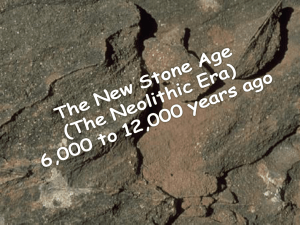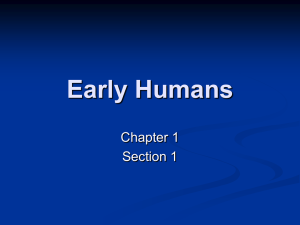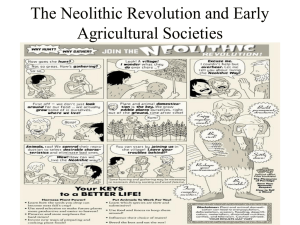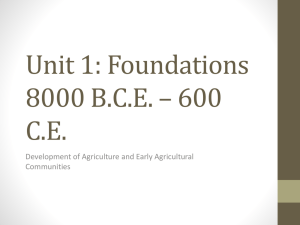PREHISTORY
advertisement
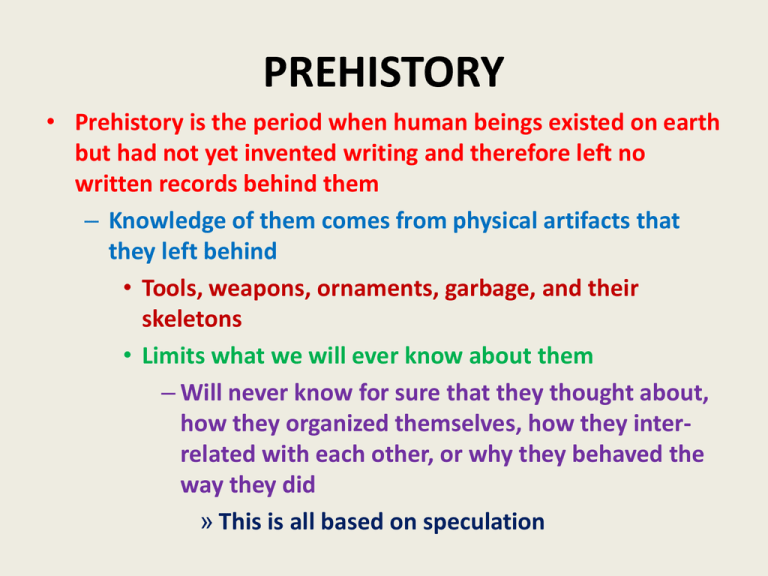
PREHISTORY • Prehistory is the period when human beings existed on earth but had not yet invented writing and therefore left no written records behind them – Knowledge of them comes from physical artifacts that they left behind • Tools, weapons, ornaments, garbage, and their skeletons • Limits what we will ever know about them – Will never know for sure that they thought about, how they organized themselves, how they interrelated with each other, or why they behaved the way they did » This is all based on speculation ORIGINS • 3 million years ago, a group of small ape-like creatures appeared along the shores of the lakes of East Africa – Brain capacity was larger than other apes of the region • Developed complex social organization in which they lived together, and cooperated in hunting, food gathering, and defense • Developed ability to make and use tools and weapons EVOLUTION • Became dominant species in region – Made possible by superior brainpower • Creatures evolved due to natural selection – A biological process in which the best traits in a species are passed on and amplified from generation to generation while negative traits are not – Became larger, stronger, smarter and less ape-like in appearance – Also began to migrate to other places in Africa MORE CHANGE • Process of simultaneous evolution, population increase, and migration continued over several million years – Caused more mental and physical change – Caused groups of them to leave Africa and settle in Middle East, Europe, Asia, and North and South America THE BEGINNING OF US • This long-term process of evolution and migration resulted in the appearance of homo sapiens sapiens – Around 200,000-100,000 BC • Lived in small groups in virtually every habitable place on the globe – Beginning of the Paleolithic Age GROWING DIVERSITY • Humans adopted behavioral patterns determined by the environment where they lived • Minor variations also appeared among humans due to environmental conditions – People who lived in northern regions lost much of the melanin in their chemical body compositions • Caused their skin to become lighter in color THE PALEOLITHIC LIFE • Paleolithic humans supported themselves exclusively by hunting and gathering • Did not establish permanent settlements but lived in temporary shelters – Moved on when supply of food ran low • Formed bands of 30 or so people and cooperated together to obtain food and protect themselves PALEOLITHIC INNOVATIONS I • Paleolithic humans made and used tools CHIMPS AND TOOLS Jane Goodall has observed chimpanzees taking a twig, stripping it of leaves, spitting on it, and then sticking it down an ant hill or termite mound to capture insects to eat She has also seen male chimpanzees grab a stick and use it as a weapon in a fight She therefore claims that chimps also make and use tools But they do not save these items for future use, nor do they make any attempt to improve them DIFFERENCE • Humans shaped a variety of materials into tools and weapons – Stone, wood, bone – Corresponded to ideas they had in their minds • Preserved creations for future use and taught other people how to make and use them TECHNOLOGICAL PROGRESS • Later generations would improve on what they had been taught and make even better ones – Result was a continual improvement in human technology – Ancestors progressed from crude, sharpened stones to spears, knives, scrapers, fish hooks, fishing nets, and the bow and arrow PALEOLITHIC INNOVATION II • Spoken language was another great achievement of the Paleolithic Age MAMMAL COMMUNICATION • Some other apes and other mammals make sounds to express emotions and communicate with each other – Notably dolphins and whales • But none of these animals can give a name to an object nor can they describe something IMPORTANCE OF COMMUNICATION • Human beings developed capacity to describe things, name things (including each other), and share their knowledge, experiences, and feelings with each other – At first did so through a combination of primitive sounds and sign language – In time, they developed spoken language • Allowed them to transmit everything they knew and had learned to others; allowed them to cooperate with other; and allowed them to teach their children survival skills. PALEOLITHIC INNOVATION III • Paleolithic people believed that the forces of nature were living things – They acted with a purpose – Nature was thus unpredictable to them • To make forces of nature act in a predictable way that benefitted human beings, they made offerings to them – Gradually medicine men and witchdoctors emerge who specialized in dealing with forces of nature through special chants, rituals, and ceremonies GRAVES • Humans also began practice of burying their dead – Bodies often posed in fetal position – Sometimes with offerings and the dead person’s tools and weapons – Indicated the development of some sort of notion of an afterlife PALEOLITHIC INNOVATION IV • Paleolithic people produced the first art in human history • Painted very skillful pictures of animals – In Africa, Asia, Europe, North and South America • Painted wherever they happened to be living but the only paintings to survive the ravages of time and weather were the ones painted inside of caves PURPOSE • “Cave Art” had something to do with magic – Many animals painted in caves are wounded • Expressing desire for successful hunt – Other paintings portray large herds of animals • Expressing hope that game would be plentiful • Paintings were part of rituals that hunters engaged in before they went out for the day BIRTH OF NEOLITHIC AGE • Human beings who lived in hills of Middle East discovered agriculture and animal husbandry – 10,000 years ago – Ushered in the Neolithic Age THE FIRST FARMERS • Women who gathered barley and wheat probably noticed that dropped seeds sprouted with time – After some experimentation, they began to cultivate small plots of land devoted to these crops • Advantages were obvious – Instead of wandering around looking for edible cereals and stuff, people could now grow them near where they lived and have guaranteed source of food DOMESTICATION OF ANIMALS • First animals to be domesticated for meat were sheep and goats – Both of whom roamed wild in the region • Advantage was that instead of tracking wild animals over great distances without any guarantee that you would find any, they could now be penned up nearby and slaughtered whenever necessary PERMANENT SETTLEMENTS • Agriculture diminished the need for humans to stay constantly on the move – Since they were no longer forced to continually follow the supply of game – Led to the establishment of permanent settlements HUMAN CONCENTRATION • Hunting required that human social groups remain small – The more reliable production of agriculture encouraged population growth and larger concentrations of people in a single area • Agriculture encouraged population growth and the development of relatively large, permanent settlements of people TRADE • Appearance of permanent settlements gave rise to trade – Neolithic farmers produced surplus of food which they traded to other groups of people elsewhere who possessed things farmers needed but did not produce themselves. • Middle Eastern farming communities traded food to people in other regions for salt, volcanic glass, and iron ore. DIVISION OF LABOR • People within Neolithic communities began to manufacture items that farmers needed but did not have the time or talent to make themselves – Traded these items for food – Pottery containers, agricultural implements, etc. PRIVATE PROPERTY • Awareness of private property developed with agriculture – The concept that this land is “mine” and that no one else could mess with it • Certain families gained more property than others – They thus gained power over the others and became “leaders” • Government and social hierarchy were created in the Neolithic farming communities of the Middle East Neolithic Age did not appear everywhere in the world at the same time. It appeared first in the Middle East and then later in other parts of the world CATAL HUYUK JARMO Agriculture would be later in other parts of the world, either indepenently or as result of contact with areas that had already discovered it JERICHO NEOLITHIC TECHNOLOGY I • Neolithic people made pottery containers for cooking and storing food and water NEOLITHIC TECHNOLOGY II Neolithic people invented the wheel and the sail Improved transportation on both land and water NEOLITHIC TECHNOLOGY III • Neolithic people invented the plow –Made farming easier and more productive NEOLITHIC TECHNOLOGY IV • Neolithic people discovered the use of metal – First to be employed was copper • Easily shaped into tools and weapons, durable, and could be recast and reshaped when they items broke – Later bronze was discovered • Alloy of copper and tin • Harder and more durable than copper, making possible better tools and weapons SUMMARY • During the Neolithic Age, food supply became more reliable, permanent settlements were established, and population increased – Families that acquired more land than others gained a higher status and became local leaders • Human society was becoming more and more organized and complex – Approached the threshold of civilization

